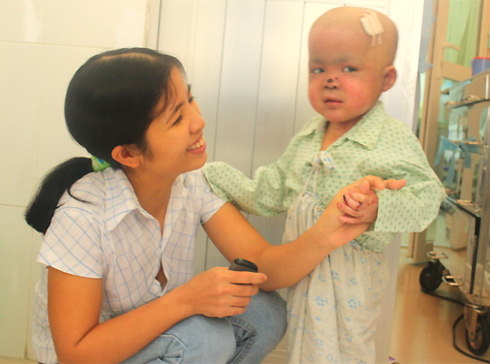
Vietnam’s National Hospital of Pediatrics in Ha Noi Thursday morning announced the initial success of its first stem cell therapy treatment of epidermolysis bullosa (EB), making it only the second medical institution in the world to successfully treat this genetic skin disease in this manner.
Vietnam’s National Hospital of Pediatrics in Ha Noi Thursday morning announced the initial success of its first stem cell therapy treatment of epidermolysis bullosa (EB), making it only the second medical institution in the world to successfully treat this genetic skin disease in this manner.
 |
| The baby and his mother. |
Children with EB lack a protein that anchors the outer layer of skin to the body, resulting in very fragile skin that peels off with minor friction or trauma. They suffer painful wounds and infections which eventually are fatal.
The four-year-old boy who underwent the bone marrow transplant received tissue taken from his sister, aged 10, on September 16, to stimulate the production of healthy skin cells.
Nguyen Viet Anh had a severe form of EB, which caused his toes to stick to each other and skin to peel off the inside of his mouth, said hospital director Nguyen Thanh Liem.
"It is a very complicated technology but we are happy that the donor’s bone marrow tissue has taken in his body," he said.
Anh’s white cell count has increased to a normal level 40 days after the transplant from almost zero. The area of affected skin is now only 7 per cent of the body, a big progress from 23 per cent before the transplant.
The boy’s mother, Tran Thi Hien, from Vinh Tuong District in the northern province of Vinh Phuc, said she was happy to see her son now able to eat without pain and that the blisters on his skin were healing.
The daughter who donated the bone marrow had recovered and was back at school only four days after the transplant. The boy was expected to leave hospital in another two weeks.
A second EB patient has been earmarked for a bone marrow transplant.
"We congratulate doctors at the National Hospital of Pediatrics for the success. This has opened a new treatment approach using stem cells," said Nguyen Van Lieu, deputy director of the technologies department under the Ministry of Sciences and Technology.
The transplant cost VND300 million (US$14,400) which was covered by insurance and the ministry’s research fund.
EB is a genetic disease with an incidence of 1/50,000. Children with EB in developed countries are usually covered with special bandages, which are too expensive for Vietnamese, Liem said.
Even with the most intensive care, EB patients usually die before age 40 and their life is of a very poor quality.
Most children with EB in Viet Nam die very young. The national children’s hospital is now taking care of 30 cases of the disease.
The US University of Minnesota Children’s Hospital was the world’s first medical institution to use bone marrow to treat EB.
(Source: Vietnamnet)




